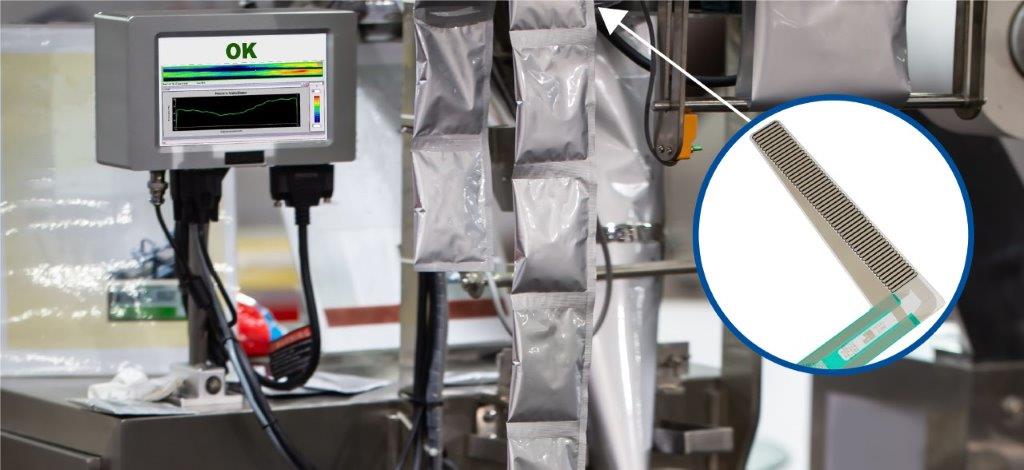How to Implement Pressure Mapping into Your Quality Control and Process Validation
In order to stay competitive, manufacturers across industries are integrating force sensing and pressure mapping capabilities into their machines and processes. Sensors quantify what is happening in the manufacturing process, from validating machine setup to measuring the forces on a delicate product going through the production line. These capabilities allow manufacturers to:
- Implement error-proofing procedures and help validate those processes for regulatory agencies (like the FDA);
- Reduce waste in the manufacturing processes, which can translate to reduced cost of goods, increased profit, and reduced carbon footprint;
- Streamline processes to avoid supply chain disruptions and stay competitive.
Error-Proofing in Food and Beverage Manufacturing
Many efforts have emerged to address the concept of preventing defects in manufacturing. Training and work instructions, no matter how well-executed or well-documented, can never completely prevent human error from occurring. Manufacturers striving for zero defects need mechanisms and devices like force and pressure sensors to help standardize their production and QC procedures, which can help them achieve better quality, improved yields, and lower costs. Manufacturers can deliver more in less time thus improving customer satisfaction and keeping the supply chain moving.
One global food and beverage processing company with plants around the world was implementing a corporate initiative to standardize their quality control procedures, and they needed a way to conduct evenness testing on a piece of packaging equipment. The food packaging industry must always maintain high standards for their packaging seals. These standards are to protect the consumer from tampering and/or receiving damaged product. Sealing bars are used to properly seal two parts of a package in a high temperature environment. Proper alignment is crucial to limiting waste and ensuring quality.
Operators often need to verify and measure alignment and don’t have time to wait for the system to cool down. Integrating pressure mapping technology into the user interface of the sealing machine and embedding the sealing bars with high-temperature pressure sensors saves time in machine setup and routine adjustments, reduces downtime and which eliminates risk of damaged product packaging.
Some of the manufacturer’s engineers were familiar with pressure mapping from their experience with Tekscan’s I-Scan System. They knew that the thin, flexible sensors would fit seamlessly into the machine, and that the software would provide all the interface pressure data they needed and then some. However, their vision was to deploy the solution in multiple factories, and since it would be in regular use by production technicians in a manufacturing setting for repeated procedures, they didn’t need all the software capabilities they would be looking for in R&D or product design, for example. What they really needed was a simplified solution that they could deploy at scale which would give them a simple visual interface to consistently validate machine alignment.
When they approached Tekscan about their dilemma, Tekscan suggested using the Software Development Kit (SDK) which is essentially an Application Programming Interface (API) that allows users to access the core functionality of Tekscan’s pressure mapping software, but with an output and display that is customized for their specific use. The beauty of this solution is that the manufacturer is able to use Tekscan’s sensors and hardware, but with a simple UI customized for their specific procedures.
What could this process look like for you? Play the video below for a glimpse:
Today, the manufacturer has implemented pressure mapping into machines in dozens of facilities worldwide, and continues to realize the benefit of standardizing their processes with Tekscan sensors and electronics with a customized user interface that allows them to easily verify the alignment of their machines.
Manufacturers Across Industries are Improving their Processes with Pressure Sensors and Pressure Mapping Technology
There are clear benefits to incorporating pressure mapping technology into food and beverage processing applications. Other industries, including Electronic Assembly, are also prime candidates for embedding pressure mapping into their processes. Most electronic assembly processes are performed by high-precision robotic systems which are tasked with properly moving and inserting delicate components onto a circuit board. Embedding pressure mapping technology into an assembly machine can help verify that all robotic elements are interfacing properly with the circuit board components. Integrating high-resolution pressure sensors, electronics, and customized software creates a seamless procedure for this sensitive process.
Automotive manufacturers know that wind, noise, and water leaks in a new vehicle can be a significant source of customer dissatisfaction and can create a perception of poor quality, not to mention generate warranty expenses. Proper adjustment of hinges and door latches while the car is in the factory and the doors are being mounted can help prevent these problems. Previously, vehicle assembly technicians have had to guess where to position the hinges and latches. To measure the pressure of the door seal, technicians would slide a piece of paper between the body and the weather strip, to feel the amount of pull in different locations.
With a pressure mapping system, assembly technicians now have an electronic “feeler” gauge that measures contact pressure, while also acting as a direct feedback mechanism. Technicians can use the gauge to help them optimize seal pressure and deflection around the door frame.
Would you like to explore how pressure mapping can you help your company improve its quality control processes? Click below to start a conversation!


